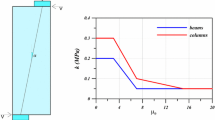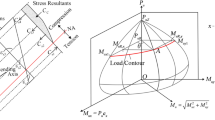Abstract
This paper presents a stress–strain curve that describes the axial behavior of concrete in circular columns with lateral reinforcement. As opposed to most studies on this subject, which used semiempirical methods, the proposed stress–strain relations are based on a theoretical derivation. They have been derived from analysis of the problem’s full range according to the theories of elasticity and plasticity. Based on these theories, the current study analytically examines the influence of the main variables, such as the volumetric lateral reinforcement ratio and the material properties, on the behavior of circular confined concrete columns and proposes theoretical expressions that describe their stress–strain relations. Application of the proposed curve shows good agreement with published test results. Since these expressions were derived from a theoretical analysis, they can be considered as an analytical verification of existing empirical curves, yet they are also simple enough for practical applications.




















Similar content being viewed by others
Abbreviations
- a :
-
Cylinder radius
- a 1, a 2, a 3, a 4 :
-
Functions that define the descending stress-strain curve
- A :
-
Constant of the failure and softening surfaces
- b :
-
Width of lateral steel reinforcement (b 1 = b/a)
- B :
-
Constant of the failure and softening surfaces
- D :
-
Gross diameter of RC column and a constant of the failure and softening surfaces
- E c :
-
Cylinder elastic modulus
- E s :
-
Ring elastic modulus
- f c0 :
-
Unconfined concrete compressive strength
- f cc :
-
Confined concrete compressive strength
- f sp :
-
Lateral steel stress at concrete peak stress
- f y :
-
Yield strength of the transverse steel reinforcement
- f yℓ :
-
Yield strength of the longitudinal steel reinforcement
- f fail , f soft :
-
Functions of the failure and softening surfaces
- f 3 :
-
p/q ratio
- F, F 1 :
-
Functions that define the stresses
- I 1 :
-
First invariant of the stress tensor
- \(I^{trans}_{1}\) :
-
Coefficient of the softening surface
- J 2 :
-
Second invariant of the deviatoric stress tensor
- k :
-
Constant with a dimension of length−1 (k 1 = ka)
- K :
-
Function that depends on the confined concrete properties
- l 1, l 2, l 3, l 4 :
-
Functions that depend on the confined concrete properties
- m :
-
Steel-to-concrete modulus ratio
- n A :
-
Parameter that defines the ascending stress-strain curve
- p :
-
Lateral pressure
- q :
-
Axial pressure
- s :
-
Clear spacing of the transverse steel reinforcement (s 1 = s/a)
- s b :
-
Center-to-center tie spacing
- t :
-
Tie thickness (t 1 = t/a)
- t eq :
-
Tie equivalent thickness (t eq1 = t eq /a)
- V s :
-
Original tie volume
- V s,eq :
-
Equivalent tube volume
- \(\epsilon_{sf}\) :
-
Fracture strain of lateral reinforcement
- \(\epsilon_{p}\) :
-
Accumulated plastic strain
- \(\epsilon_{pult}\) :
-
Ultimate accumulated plastic strain at which the stress state reaches the residual strength envelope
- \(\epsilon_{z}\) :
-
Axial strain
- \(\epsilon^{0}_{z}\) :
-
Axial strain at zero volumetric strain
- \(\epsilon^{lim}_{z}\) :
-
Axial strain at which cracking occurs in the lateral direction
- \(\epsilon_{c0}\) :
-
Concrete compressive strain corresponding to unconfined concrete strength
- \(\epsilon_{cc}\) :
-
Concrete compressive strain corresponding to confined concrete strength
- \(\epsilon_{c85}\) :
-
Strain at 85% of the confined concrete strength
- \(\epsilon_{v,max}^{u}\) :
-
Maximum volumetric contraction strain experienced by the confined concrete
- ν :
-
Poisson’s ratio
- ψ :
-
Softening parameter
- ρ v :
-
Volumetric ratio of transverse steel reinforcement
- ρ vf :
-
\(\rho_{v}f_{sp}/f_{c0}\)
- ρ vfy :
-
\(\rho_{v}f_{y}/f_{c0}\)
- σ lat :
-
Lateral (radial) stress
- ϕ t :
-
Cross-section diameter of transverse steel reinforcement
References
Park R, Priestley MJN, Gill WD (1982) Ductility of square-confined concrete columns. J Struct Eng 108(4):929–950
Fafitis A, Shah SP (1985) Predictions of ultimate behavior of confined columns subjected to large deformations. ACI Struct J 82(4):423–433
Hoshikuma J, Kawashima K, Nagaya K, Taylor AW (1997) Stress–strain model for confined reinforced concrete in Bridge Piers. J Struct Eng 123(5):624–633
Sheikh SA, Uzumeri SM (1980) Strength and ductility of tied concrete columns. ASCE J Struct Div 106(5):1079–1102
Sheikh SA, Uzumeri S (1982) Analytical model for concrete confinement in tied columns. J Struct Div 108(12):2703–2722
Mander JB, Priestley MJN, Park R (1988b) Theoretical stress–strain model for confined concrete. ASCE J Struct Eng 114(8):1804–1826
Sheikh SA (1982) A comparative study of confinement models. ACI J 79(4):296–306
Cusson D, Paultre P (1995) Stress–strain model for confined high-strength concrete. ASCE J Struct Eng 121(3):468–477
Razvi SR, Saatcioglu M (1999b) Confinement model for high-strength concrete. ASCE J Struct Eng 125(3):281–289
Légeron F, Paultre P (2003) Uniaxial confinement model for normal- and high-strength concrete columns. ASCE J Struct Eng 129(2):241–252
Karabinis AI, Kiousis PD (1994) Effects of confinement on concrete columns: plasticity approach. J Struct Eng 120(9):2747–2767
Ahmad SH, Shah SP (1982a) Complete triaxial stress–strain curves for concrete. J Struct Eng 108(4):728–742
Ahmad SH, Shah SP (1982b) Stress–strain curves of concrete confined by spiral reinforcement. ACI Struct J 79(6):484–490
Eid R, Dancygier AN (2005) Partially confined circular members subjected to axial compression: analysis of concrete confined by steel ties. Struct Eng Mech 21(6):737–765
Eid R, Dancygier AN (2006) Confinement effectiveness in circular concrete columns. Eng Struct 28(13):1885–1896
Sheikh SA, Toklucu MT (1993) Reinforced concrete columns confined by circular spirals and hoops. ACI Struct J 90(5):542–553
Razvi SR, Saatcioglu M (1999a) Circular high-strength concrete columns under concentric compression. ACI Struct J 96(5):817–825
Eid R (2004) Structural analysis of partially confined reinforced concrete in members with axi-symmetric cross-section and loading. PhD thesis, Department of Civil and Environmental Engineering, Technion - Israel Institute of Technology, Haifa, Israel
Timoshenko SP, Goodier JN (1970) Theory of elasticity. McGraw-Hill, Tokyo, pp 422–428
Imran I, Pantazopoulou SJ (2001) Plasticity model for concrete under triaxial compression. ASCE J Eng Mech 127(3):281–290
Ortiz M, Simo JC (1986) An analysis of a new class of integration algorithms for elastoplastic constitutive relations. Int J Numer Methods Eng 23:353–366
Eid R, Dancygier AN, Paultre P (2007) Elastoplastic confinement model for circular concrete columns. ASCE J Struct Eng 133(12):1821–1831
Drucker D, Prager W (1952) Soil mechanics and plastic analysis or limit design. Quart Appl Math 10:157–165
Comite Euro-International Du Beton (1993) CEB-FIP Model Code 1990. Thomas Telford, No. 40
Mander JB, Priestley MJN, Park R (1988a) Observed stress–strain behavior of confined concrete. J Struct Eng 114(8):1827–1849
Cusson D, Paultre P (1994) High-strength concrete columns confined by rectangular ties. ASCE J Struct Eng 120(3):783–804
Imran I, Pantazopoulou SJ (1996) Experimental study of plain concrete under triaxial stress. ACI Mater J 93(6):589–601
Sargin M (1971) Stress–strain relationship for concrete and the analysis of structural concrete section. PhD thesis, University of Waterloo, Ontario, Canada
Li B, Park R, Tanaka H (2001) Stress–strain behavior of high-strength concrete confined by ultra-high and normal-strength transverse reinforcement. ACI Struct J 98(3):395–406
Iyengar KTSR, Desayi P, Reddy KN (1971) Stress–strain characteristics of concrete confined in steel binders. Mag Concr Res 22(72):173–184
Eid R, Roy N, Paultre P (2009) Normal and high-strength concrete circular columns wrapped with frp composites. J Compos Construct 13(2)
Cusson D, De Larrard F, Boulay C, Paultre P (1996) Strain localization in confined high-strength concrete columns. J Struct Eng 22(9):1055–1061
Carreira DJ, Chu KH (1985) Stress–strain relationship for plain concrete in compression. ACI J 82(6):797–804
Hsu TTC, Floyd FO, Struman GM, Winter G, Olsefski S (1963) Authors’ reply to the Bellier, J., and Schneider, B., discussion of “Microcracking in concrete”. ACI J 60(12):1817–1819
ACI 318 (2008) Building code requirements for structural concrete. American Concrete Institute, Farmington Hills, Michigan, USA
Paultre P (2001) MNPHI: user manual. Technical Report CRGP Report 2001-01, Department of Civil Engineering, University of Sherbrooke, Sherbrooke, Canada
Osorio LI, Eid R, Paultre P, Proulx J (2008) Behavior of synthetic fiber-reinforced concrete circular columns under cyclic flexure and constant axial load. In: 37th Annual Conference, Canadian Society for Civil Engineering. Quebec City, Canada
Author information
Authors and Affiliations
Corresponding author
Appendix A
Appendix A
The constants of the Imran and Pantazopoulou concrete constitutive model [20] are:
For the axisymmetric cylinder under the axial stress (σ 3) and the equivalent uniform lateral pressure (\(\sigma_{1}=\sigma_{2}\ge\sigma_{3}\)—compression negative), the first invariant of the stress tensor, I 1; the second invariant of the deviatoric stress tensor, J 2; and the major principal stress, σ 1, are:
Rights and permissions
About this article
Cite this article
Eid, R., Dancygier, A.N. & Paultre, P. Stress–strain curve for concrete in circular columns based on elastoplastic analysis. Mater Struct 43, 63–79 (2010). https://doi.org/10.1617/s11527-009-9470-6
Received:
Accepted:
Published:
Issue Date:
DOI: https://doi.org/10.1617/s11527-009-9470-6




